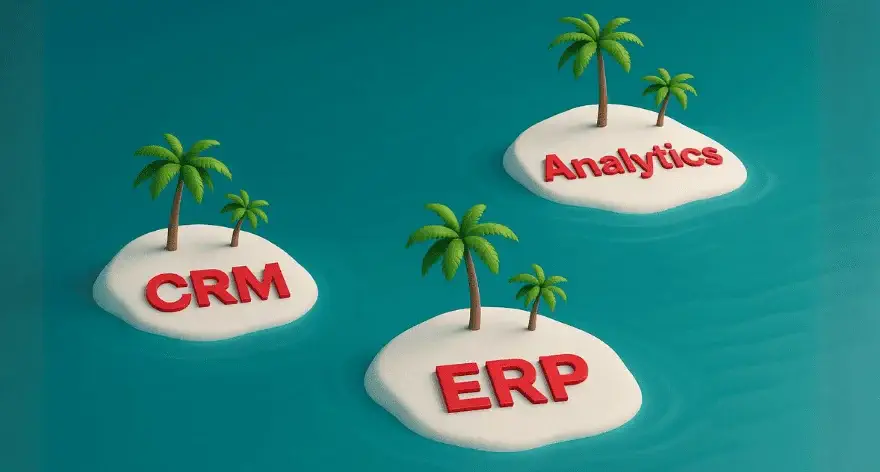AI Readiness - Index
What is AI Readiness and why is it essential?

The promises and pitfalls of AI
AI is trending, and that makes sense: automation, smarter marketing, better decisions — the promise is big. Companies are therefore investing heavily. Yet only 1% of leaders say their organization is truly AI-mature, according to McKinsey. That means AI is fully embedded in processes and producing results. For the rest, not.
Many AI projects remain stalled. Gartner found that 85% fail. Reason? Poor data and too little understanding of what is truly needed. The focus is often on the tool, not the context. Likewise McKinsey warns: 70% of digital transformations fail. AI is not a plug-and-play solution. Without proper preparation you may spend millions on a model that solves nothing.
A common scenario: management is excited after a successful pilot or demo. But the real work — data quality, integration, legacy systems — is forgotten. Result: headaches during implementation, disappointing results, and an AI model that never advances beyond pilot phase.
AI only works as well as the data it’s built on
Many AI projects fail for one simple reason: poor data. AI is only as good as the input you put in.Garbage in, garbage out”. Poor or incorrect data leads to unreliable outcomes. MIT Sloan Management Review already warned: deficient data undermines decision-making and pulls down generative AI projects.

Without good data quality no AI model performs well. Machine-learning algorithms learn from historical data. If bias or noise is present, the model simply inherits it. No wonder that poor data is often cited as the cause of failing AI initiatives.
McKinsey observed that companies with successful AI first got their data in order. Data must be findable, understandable, available, purposeful and secure. Gartner adds: also ethical, accurate, enriched and free of bias.
In short: don’t start with AI, start with your data. AI Readiness is about the right foundation. You must have your data, technology, people and processes ready. Only then can you let AI work. In the next section we zoom in on the most underestimated part: data. Indispensable, but often forgotten.
The role of data in AI Readiness
AI learns from data. The more relevant and clean the data, the better the output. Leading companies collect enormous amounts of information, from customer behaviour to supply-chain data. “In machine learning and AI, there’s never enough data,” said an expert. Many AI projects fail because the models don’t get enough qualitative input.
Data therefore must be in order both in quantity and quality. Think of it as fuel: clean petrol lets an engine run; dirty causes problems. The same applies to AI. 84% of data experts spend daily time cleaning data. Raw data must first be filtered before AI can perform. So invest in solid data foundations: platforms, integrations, quality tools. The better your data is organised, the quicker you move from AI pilot to practice.
Every day, we analyze large volumes of data. Through algorithms and extensive processes, we calculate our bankruptcy scores and Paydex. In a credit report, you'll find multiple scores. Let's go through them one by one.
Why your existing (customer) data is crucial
In a world with stricter privacy rules and vanishing cookies, the data your organisation already holds becomes increasingly valuable — especially for AI. Think of data from your own systems, processes and customer contacts.
AI works best with this type of data. Because it reflects behaviour and processes that are truly yours. That way you can make personalised recommendations based on customer behaviour, or optimise your stock with data from your own chain.
You also keep control yourself. You’re not dependent on external parties and you build AI models based on information you already have. That yields better segmentations, predictive insights and sharper decisions.
In short: treat your own data as the foundation of AI. Ensure that foundation is strong: maintain high quality, enrich where needed, and make use of what you already have.
CRM, ERP and other data sources
Organisations often have lots of data that is usable for AI — from customer information in CRM to operational figures in ERP. Web analytics and external sources can also be valuable. But all that data is spread across systems and departments that hardly talk to each other.
Marketing works in a CRM, finance in an ERP, IT with log files, web teams with analytics. The result? Data islands. And without connection between them AI remains limited. You miss the total picture needed to generate truly smart predictions or insights.

AI only performs well if it gets a complete picture: all relevant data, combined and aligned. That’s why data integration is essential for AI-readiness. According to MIT Technology Review this is the priority for organisations that seriously want to use AI.
But the more data sources you use, the more responsibility you have. Who owns which data? What is the quality? And who has access? AI can only be truly valuable if you have this foundation in order. We also call this data governance.
In the next section we dive deeper into the data bottlenecks that often bring AI projects down.
Common data-challenges in AI projects and how to deal with them
As you have read so far, data is the essential component for AI Readiness. But as already discussed, data comes with challenges that return almost everywhere. We discuss the three most common challenges and how to solve them.
- Poor data quality
Many organisations think their data is in order — until they want to model with it. Then fields turn out empty, inconsistent or outdated. For instance customer records without industry classification, suppliers without up-to-date address data, or duplicate accounts. - Silos and inconsistent formats
Data is often spread across different systems. In one system it says “Netherlands”, in another “NL”. Without standardisation you cannot combine or analyse those data, let alone automate. - Incomplete context
Even if your internal data is correct, often valuable external context is missing. For example the creditworthiness of a customer or the parent company of a supplier. Without those extra layers your AI model remains limited in its insights. - Data obsolescence
Data changes continuously: companies relocate, change legal structure, go bankrupt or are acquired. Without regular updates you work with outdated reality.
How companies can improve their data quality
Now the pain points are clear, the question becomes: how do you solve them? Below we discuss concrete steps to improve your data quality, and thereby lay the foundation for successful AI-projects.
- Improve data quality via audits, cleaning and standardisation
The first step is knowing where you stand. With a data audit you map out:
- Which data sources do you use?
- How complete are your fields?
- Where are errors or gaps?
Tools for data profiling help by, for example, detecting empty fields, outliers or illogical values. Based on that you set up a cleaning project, with actions such as:
- Remove duplicate data: detect duplicate records (by company name, email or registration number) and merge them.
- Remove outdated data: archive or delete records no longer valid, such as companies that no longer exist.
- Fill missing values: supplement critical fields via internal sources or external data (see also enrichment below).
- Apply standardisation: use consistent formats, such as +31 for phone numbers or fixed spellings for countries and addresses.
Tip: hold a periodic CRM Cleanup Day or use tools that perform continuous data validations.

Without standardisation you end up comparing apples and oranges — disastrous for AI. By harmonising data before you model, you prevent the scenario “train model, find error, start again”.
An added benefit: cleaner data not only improves your AI-readiness, but also your daily processes. Think of fewer failed mailings, more accurate reports, and better customer interactions.
- External data enrichment as a turbo on your existing data
Even after thorough cleaning you often still miss the context needed to build truly valuable AI models. Here data-enrichment comes into view: supplementing your internal data with external sources.
A data-company (such as Altares) has global business data and can link a simple datum (such as a registration number) to dozens of additional fields, such as:
- Industry codes (SBI/SIC)
- Revenue category
- Number of employees
- Legal structure
- Parent and subsidiary companies
- Credit risks
- Board members and contact persons
Example: Your CRM lists “Acme BV” with an invoice address. Through enrichment you learn that Acme is part of a larger group, has 250 employees, a particular credit score and a new director.
With external solutions such as for example dataxess you automatically enrich your CRM records. Result: richer customer profiles, directly available for sales, marketing and risk.
The benefits for AI:
- More features = better model
The more relevant characteristics you add, the more powerful your AI model becomes. Think of better segmentation, more accurate predictions, smarter scoring.
- Always up-to-date data
Altares continuously maintains its databases. By synchronising periodically you automatically benefit from those millions of annual updates. So your dataset remains current — without extra work.
Tip: choose enrichment wisely. Not every extra data point is relevant. Match external data smartly to your KPIs and ensure a good technical connection (such as via D-U-N-S® numbers).
The role of Master Data Management in AI
If you want to make reliable, scalable AI, you cannot avoid a solid data governance component. Master Data Management (MDM) is often a logical step in that. In this section we explain what MDM means, why it matters for AI, and how it works in practice, with a concrete example.
What is Master Data Management?
Master Data Management is a way to centrally manage important company data, such as customer, supplier or product information. The goal is simple: create a single version of the truth (Single Source of Truth), on which all systems can rely. That means for example:
- Using unique identifiers to link data from different systems, such as using a D-U-N-S® number to make business information consistent.
- Consolidating and cleaning data: duplicate or conflicting records are merged according to fixed rules
- Feed back to systems: the cleaned, enriched data is shared back with local tools like your CRM or ERP.
Interesting read: All about Master Data Management
MDM thereby addresses a common problem: data silos. Organisations often use multiple data sources in which the same entity is recorded slightly differently. Think of a customer who appears in three places with three different spellings. That leads to errors, duplicate communication or wrong analyses. With MDM you fix that by streamlining everything centrally.
Why MDM is crucial for AI
If you deploy AI models that combine data from multiple systems, for example customer interactions and financial data, then consistency is essential. Models must be able to rely on correct, complete and up-to-date data. Without that you risk wrong insights or poor predictions.
MDM ensures that ‘Customer A’ in system 1 is really the same as ‘Customer A’ in system 2. That seems simple, but in practice is often a big challenge. Especially with older IT landscapes or rapid growth.
Moreover, good data management reduces the workload of data analysts and AI teams. Less time spent verifying, correcting or deduplicating means more time for valuable analyses

How this works in practice?
An example of how MDM might look is a solution such as dataxess.This solution links external business data to your own systems (such as CRM and ERP) and performs four core actions:
- Cleaning: duplicate or incorrect business details are corrected.
- Improve input: new customers or suppliers are correctly and fully added via a search function.
- Enrich: your own customer or supplier profiles are supplemented with external data — such as industry, credit score or directors.
- Maintenance: changes such as acquisitions, bankruptcies or address changes are automatically processed.
In effect you apply a form of MDM within a specific domain: customer and supplier data. Organisations that do this often find that data management suddenly costs less time and is less error-prone. And more importantly: it increases the reliability of analyses and AI applications.
In summary
MDM is not a goal in itself, but a necessary prerequisite for datadriven work. If you want to build on your data, — whether for reporting, customer analyses or AI —, you must have the foundation right. A good MDM approach ensures that: less chaos, less noise, more trust. Tools such as dataxess are a way to make this concrete, but it always begins with the decision to take your data seriously.
The next step: AI Data Consultancy
Even if your data foundation stands and you have the right tools and technologies, AI implementation is rarely a straightforward process. The leap from ‘wanting’ to ‘doing’ proves challenging for many organisations. Where do you start? What is feasible? How do you maintain control over costs, risks and expectations?
This is precisely where AI Data Consultancy comes into play: external guidance by experts who are not only technically skilled but also understand what AI means for your organisation, your people and your processes.

Why organisations need external guidance
AI touches multiple layers at once: technology, data, strategy and culture. Many organisations know they “must do something with AI”, but struggle with questions such as:
- Which use cases are relevant and feasible?
- Is our data suitable for AI, or do we only think so?
- How do we ensure business and IT understand each other?
- How do we train our people and create buy-in?
Such questions are not answered by simply installing a software package. They require insight, planning and change.
What often goes wrong is that top management thinks the organisation is already ‘AI-ready’, while the people on the work floor still deal daily with poor data. Research shows that nearly 90 % of executives believe their data-ecosystem is ready for AI at scale, while in the same survey 84 % of IT and data workers said they spent hours each day solving data-issues. That gap between perception and reality causes delays and frustration.
An external consultant brings objectivity. They perform a baseline assessment, ask critical questions, and clarify what is really needed for successful AI implementation. They bridge strategy and execution, business and IT. Consultants create shared understanding, set realistic expectations and bring structure to the project.
Where external parties can help
- Baseline measurement and analysis
Consultants often start with an assessment of your data infrastructure, quality and governance. They also look at organisational aspects: is there a clear vision? Are the right roles and responsibilities in place?
- Use case selection and prioritisation
Together with stakeholders you identify feasible and valuable AI applications, aligned to strategic goals and available data.
- Scaling up pilots
Starting AI experiments is one thing; structural integration into processes, IT systems and governance is another. Here change management, compliance and IT architecture come into play.
- Best practices and avoiding pitfalls
Consultants have experience with various organisations and sectors. They know which approach works, and where it often goes wrong. For example: don’t immediately jump on the AI hype-train, but work in phases and with measurement points.
- Guidance in data governance and ethics
In the context of privacy legislation (such as GDPR) and ethically responsible AI use, it’s important to build the right guidelines and checks & balances. An external party can advise and support this.
- Adoption and buy-in
Successful AI is people work. Training, workshops and communication help create buy-in and make employees comfortable with new ways of working or insights. External guidance can be an accelerator here.
- Fresh perspective
Internal teams often sit deeply in their own processes and assumptions. An external consultant sees blind spots more quickly, such as missing datasets or under-used data sources, and helps find solutions.
- Structure and pace
In busy organisations it’s tempting to “do AI on the side”. But without structure and pace, projects quickly bog down. A consultant helps starting a roadmap, setting priorities, monitoring progress and steering where necessary.
Conclusion
AI Data Consultancy does not mean handing over the steering wheel. On the contrary, , it’s a collaboration. You know your business, the consultant knows data, technology and change processes. Together you work on a realistic plan where the correct steps are taken: first the foundation (data quality and governance), then the AI models. With external guidance you reduce risks, increase the chance of results and ensure AI doesn’t end up stuck in good intentions.
Checklist: Is your organisation AI-ready?
So far we have discussed the components of AI Readiness, especially in the area of data. Below is a short checklist with questions you as an organisation (C-level, data team, marketer, — relevant for everyone) can ask yourself to gauge how AI-ready you are. If you answer several of these questions with “no”, you know where to take action:

- Do we have a clear AI strategy and business case? In other words, do we knowwhyandwherewe want to use AI, aligned to our business goals? Without a focused vision, AI can get lost in loose experiments.
- Is our data quality in order? Are our core datasets (e.g. customer and supplier data) accurate, complete and up-to-date? Are duplicate records and errors minimal, and do we have processes to keep data clean (AI and data qualitymust go hand in hand).
- Do we have sufficient first-party data for AI? Do we have the necessary amount of relevant own data to feed AI models, and can we enrich it with external sources (such as data enrichment via Altares) for extra context?
- Have we broken down data silos and integrated systems?Does data flow freely between departments (CRM, ERP, marketing, etc.), or are we still dealing with islands? AI can only perform optimally with access to integrated, standardised datasets.
- Do we have the right infrastructure and tools?Think about sufficient IT infrastructure (cloud, databases) to support AI, but also tools like MDM (master data management) for a single source of truth, and potential ML platforms. Simply put: is our “tech stack” ready for AI implementation?
- Is our organisation (people & culture) ready for AI? Do we have sufficient skills in house (or via partners) to work with AI, from data scientists to change managers? Are employees open to data-driven working, and is there leadership buy-in to support AI projects?
- Have we secured governance and ethics? Are there guidelines for data privacy, security and ethical AI use? AI Readiness also means you handle data and AI responsibly, comply with legislation and act socially responsible.
Use this checklist as a starting point. A truly AI-ready organisation can answer “yes” to most of these questions. If not, you now have insight into where you can improve, and can take targeted measures (or engage experts) to bring those aspects up to standard.